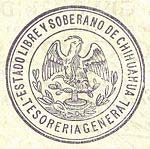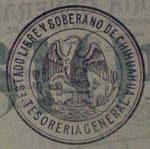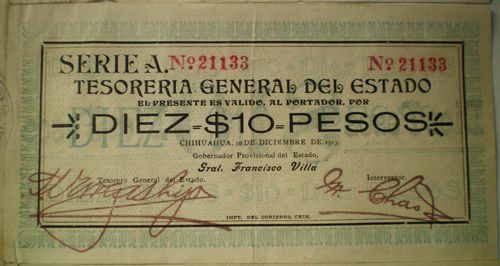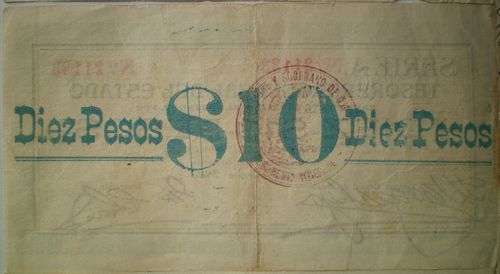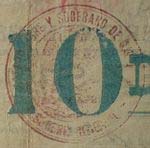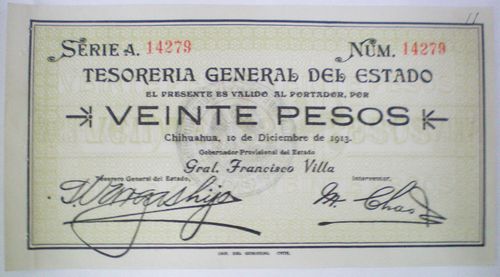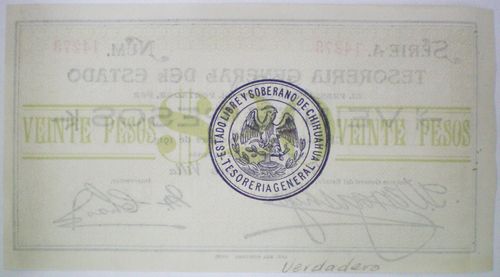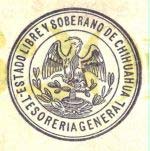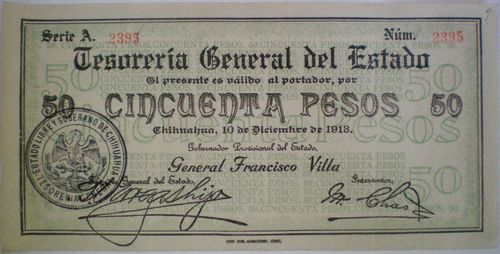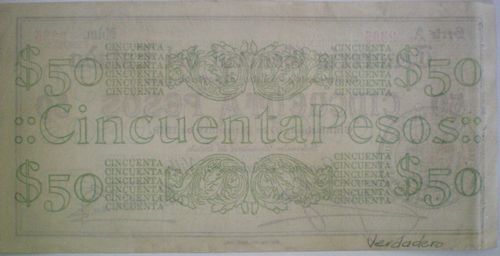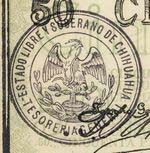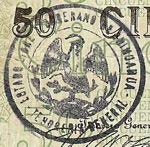The counterfeits from the Alvarado Mining and Milling Company
On 20 March 1914 the Governor of Chihuahua, Manuel Chao, learnt that the Alvarado Mining and Milling Company, of Parral, had bought a large quantity of (counterfeit) sábanas in El Paso and ordered the Presidencia Municipal of Parral to inspect its books and holdings of cash. The inspection that evening revealed that the company had $4,305101 $5 notes, 216 $10 and 82 $20 (AMP, Gobieno, Jefatura Política y Presidencia Municipal, Libros Minutarios, AL12-13-000-103) in counterfeit notes and on 24 March F. G. Hawkins, Jr., assistant manager of the company, had handed in another $5,21016 $10, 240 $20 and 5 $50 (figure given as $5,340 in AMP, Gobieno, Jefatura Política y Presidencia Municipal, Libros Minutarios, AL12-13-000-103), which he said were counterfeits that had been given out to people and subsequently exchanged for good notes.
On the same evening of 20 March Nieves Elizondo, of the firm 'Ronquillo y Elizondo' reported that his company had received a little over $4,980 from the Alvarado and brought in $3,700 (all in $20 notes) to check whether it was legitimate or not. All of these notes proved to be false. Over the next few days various individual handed in further notes that they had received, by 23 March a total of $1,690, by 25 March another $1,4951 $5, 16 $10, 64 $20 and 1 $50, by 27 March a further $3751 $5, 8 $10, 12 $20 and 1 $50, on 28 March $8755 $10 and 41 $20 and by 7 April a further $1,170. By the time the case had died out, and the Governor agreed to the notes being deposited with the Tesorería General, the total sum of counterfeit notes involved was $19,010receipt from Tesorero General Sebastian Vargas, 23 November 1914.
Recorded numbers were as follows:
| Date | Consignor | Value | Series | Number | Total |
| $5 | A | 6118 to 6142; 6288 to 6318; 6321 to 6326; 6408 to 6413; 6456 to 6464; 6499 to 6500; 15715 to 15717; 15843 to 15860 |
$500 | ||
| $10 | A | 8001 to 8046; 8145 to 8198; 11777 to 11927; 11954 to 11997; one unnumbered | $2,000 | ||
| $10 | A | 11905 to 11916 | $120 | ||
| $20 | A | 761-851-904-920-929-1691-1700-1755-1809-1810-1839-1908-1939-1946- 1995-2026-2156-2162-2163-2284-2287-2386-2387-2391-2395-2432-2443- 2499-2501-2588-3941-4962-5044-5228-5504-5510-5526-5534-5691-5810- 5815-6001-6002-6008-6019-6138-6147-6149-6158-6169-6186-6353-6362- 6392-6398-6801-6890-6892-6898-7220-9142-9225-10392-10408-11450- 11451-11454 |
$1,340 | ||
| $20 | A | 1689-1779-1806-2023-2433-2595-5221-5222-5511-5696-5736-5743-5819- 6187-11455 |
$300 | ||
| 21 March | Nieves Elizonda | $20 | $3,700 | ||
| 22 March | Juliá Santiesteban | $20 | A | 902-1894-2495-3003-3025(?)-4102-4127-5531-5936-6021-8704-9220- 10426(?)-10446 |
$280 |
| $1,690 | |||||
| $1,485 | |||||
| $375 | |||||
| $870 | |||||
| 22 May | José Maria Garza (Recaudador de Rentas) | $20 | A | 2111 | $20 |
| 2 June | Jorge Rivera | $50 | A | 5062 | $50 |
| 15 June | Antonio Ontiveros | A | 13135 |
The local judge started an investigation. Eduardo E. Johnson, the company’s cashier, said he had bought about $15,000 in currency in El Paso and some other from the Tesorería General del Estado. Another employee of the Alvarado, J. Y. Baskin, said that on 11 March he had brought eight packets from El Paso, with $29,713 in $5, $10, $20 and $50 and on 13 March entrusted the money to the Alvarado company.
On 31 March the Presidente Municipal ordered the arrest of Hawkins, Johnson and a third American, Eduardo A. Powers. Hawkins and Johnson were held incommunicado: Powers was the American consular agent and claimed special privileges but the Presidente Municipal repeated the request for his arrest on 1 April. On the same day McQuatters, the president of the Alvarado Mining and Milling Company called on Lazaro de la Garza in Ciudad Juárez and said that he bore total responsibility for what had happened and asked for his two employees to be released. McQuatters said he was disgusted at having put the counterfeits into circulation and promised in future to buy only from the Tesorería del Estado. De la Garza suggested to Chao that they take advantage of the situation as the Agencia was urgently in need of fundsLG papers, 3-C-25, telegram L. de la Garza, Ciudad Juárez, to Chao, Chihuahua. 1 April 1914. Chao also received representations from Marion Letcher, the American consul in Chihuahua, and replied to de la Garza, agreeing and adding that he had already ordered the prisoners' release on bailLG papers, 3-C-6, telegram Chao, Chihuahua, to L. de la Garza, Ciudad Juárez, 1 April 1914 though the next day McQuatters complained that not only had his employees not been released, but Powers had also been arrestedLG papers, 3-C-27, telegram L. de la Garza, Ciudad Juárez, to Chao, Chihuahua. 2 April 1914. Chao said on 3 April that they should already have been freed (LG papers, 3-C-36, 3-C-6, telegram Chao, Chihuahua, to L. de la Garza, Ciudad Juárez, 3 April 1914). On 2 April Chao sent de la Garza 8,000 U.S. dollars and asked him to ask McQuatters for another 20,000, either as a loan or through the sale of currency, to make up the 30,000 dollars that Villa wanted to buy cattle (LG papers, 3-C-31, telegram Chao, Chihuahua, to L. de la Garza, Ciudad Juárez. 2 April 1914). A note entitled Purchases of dos caritas (Compras “Dos Retratos”) shows that between 9 and 13 April they sold $127,390 for a total of $9,234.41 U.S. dollars (about 7.25 cents on the peso), most probably to the Alvarado Mining and Milling Company (LG papers, 3-C-50).
The Chihuahua newspaper, Vida Nueva, called for exemplary punishments, pour encourager les autresVida Nueva, 2 April 1914. However, the American newspapers reported that the Americans has bought the money in good faith to pay their employees and that Letcher anticipated little difficulty in straightening out the matterNew York Times, 3 April 1914. Various other employees were arrested, but they were released on 1 May. The matter dragged on, with Johnson and Hawkins at liberty, and it seemed they ultimately suffered no penalty, apart from losing the value of the counterfeit notes.
Two experts, Jesús Fierro Ibarra y José Murillo, examined the notes, unfortunately comparing them with just single examples of each value that they had received from the Tesorería General (via the Recaudador de Rentas). In the case file the four counterfeit notes are marked 'Genuine' (Verdadero) whilst the genuine examples are marked Falso, which does nor inspire much confidence. The differences they noted were as follows.
$5 sábanas
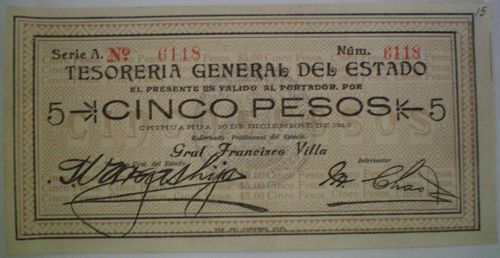
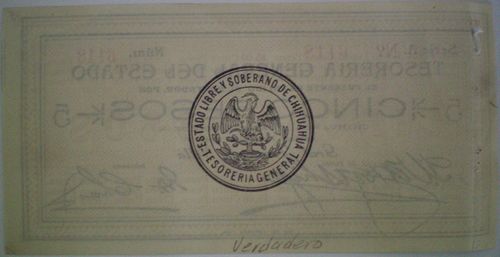
| GENUINE | COUNTERFEIT |
| Thicker lettering | |
| Blacker ink | |
| Exterior design is156½mm by 75¾mm | Exterior design is 156½mm by 74½mm |
| Interior thick line is 144mm by 73mm | Interior thick line is 143½mm by 72mm |
| At right red “No” | Black “Núm” |
| Background formed by small regular squares, in darker ink | Dots are irregular, and lighter |
| Vargas’s signature thicker | |
| Word “Interventor” is hardly legible |
|
|
|
|
|
|
|
| Occasional breaks in the eadging, particularly in the corners | Edging is blacker, thicker and formed by a single line |
|
In seal 'TESORERIA GENERAL' is between two bars |
No bar after 'GENERAL' |
The experts did not comment on the fact that their counterfeit example, A 6118, has "Gobernado" instead of "Gobernador".
This is counterfeit Type 2, where more distinctions are noted.
$10 sábanas
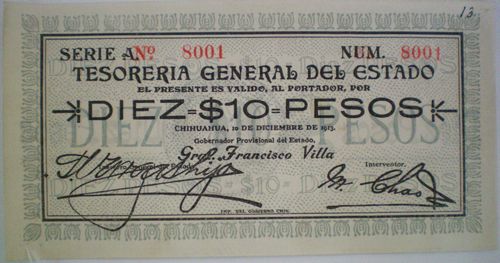
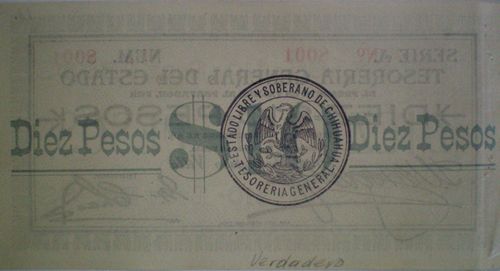
| GENUINE | COUNTERFEIT |
| Much thicker lettering | |
| Blacker ink | |
| outside edging line is much thicker | |
|
Over "NUM." a "No." in faint red ink |
|
| Names and signatures of Tesorero and Interventor much thicker | |
| Background of spots regular | Background of spots in complete disorder |
| Occasional breaks in the edging, particularly in the corners | Edging is blacker, thicker and formed by a single line |
| Seal is rubber and applied by hand, so details of the eagle and lettering are blurred In seal “TESORERIA GENERAL” is between two bars |
No bar after “GENERAL” |
In addition we can note that the genuine note has a blue background, and the counterfeit a grey background, and that in the counterfeit there is a larger gap between the left vertical row of adornments and the top and bottom horizontal rows.
This is counterfeit Type 1.
On 13 May Fierro Ibarra and Murillo inspected 15 notes (with total value $190) and remarked on the following seven notes (Series A 21126, 21140, 21151, 21155, 35616, 35728, 35730), listed as $20s in their report but obviously $10s.
| GENUINE | COUNTERFEIT |
|
|
|
| Numbers in red |
|
| Smaller type | |
| Point at centre of the five rays on either side of DIEZ PESOS |
|
|
|
|
|
|
|
|
|
|
| Corner edges are lightly separated | Edges are very open (bastante desprendidas) |
| 'Diez $10 Pesos' in black is invariably placed at the centre of the same phrase in blue | |
| Blue background very faded (muy deblavado) | |
|
Treasury seal never less than 40mm
|
The eagle is (muy arrimada en la parte superior del circuito interior del sello) The snake’s jaws are open The cactus does not have a trunk A ribbon joins the laurel branches The left wing and left branch are almost white Much greater gap between 'ESTADO LIBRE Y SOBERANO DE CHIHUAHUA' and 'TESORERIA GENERAL' |
This is counterfeit Type 2.
$20 sábanas
| GENUINE | COUNTERFEIT |
| Thicker lettering | |
| Blacker ink | |
| Design is 160mm by 80mm | Design is 160mm by 80mm |
| At left after SERIE A a red “No.” | No “No.” |
| At right a red “No.” | Black “NUM” |
| imprint “IMP DEL GOBIERNO, CHIH.” is 23mm | Imprint is 25mm, in larger type and has a full stop after Gobierno |
| The green adornments are formed of small stars, each one enclosed in a perfect square, with fine white dividing lines | The adornments appear a single piece |
| No comma after “Gobernador Provisional del Estado” | |
|
|
|
| Chao’s signature ends in a round point (bola) | |
| Occasional breaks in the edging, particularly in the corners | Edging is blacker, thicker and formed by a single line |
|
Seal is rubber and applied by hand, so details of the eagle and lettering are blurred |
No bar after “GENERAL” |
This is counterfeit Type 1, though the experts compared the counterfeit with only one type of genuine note, and there is in fact another genuine type with a single 'Núm.' on the right.
The experts commented that $20 A 9142 seem to share details from both the genuine and the counterfeit notes, since its dimensions, general colour, and print type were the same as the genuine notes but it had the black abbreviation “NUM” instead of the red “No”. The seal also appears to be be of cauchua or rubber, but it differs from the genuine seals in size and the space between “ESTADO LIBRE Y SOBERANO DE CHIHUAHUA” and “TESORERIA GENERAL”. It resembled the counterfeits in having “NUM”, (red No at left), the imprint “IMP. DEL GOBIERNO, CHIH.”, and the bola at the end of Chao’s signature. They left it to the judge to decide whether it was genuine or not. We would probably accept it as genuine.
$50 sábanas
Fierro Barra and Murillo's comments were:
| GENUINE | COUNTERFEIT |
| Thicker lettering | |
| Ink is sepia (café oscuro) | Blacker ink |
|
The point at the beginning of Vargas’ seal coincides with the “R” of “TESORERIA” in the seal |
|
| Green ink of background is clearer | |
| Red 'No' after 'SERIE A' | No 'No' |
| Red 'No' at right | Black 'Núm.' |
| The shading in the upper part of “50 CINCUENTA PESOS 50” is distinct, separate lines | Shading is formed by thinner lines, that are oftren joined |
| Design is 189mm by 88½mm | |
| Chao’s signature has an inkspot at the far right flourish (el vértice superior y derecho de la firma hay un burrón en forma de punto) | No inkspot |
|
|
|
| Occasional breaks in the edging, particularly in the corners | Edging is blacker, thicker and formed by a single line |
|
In seal 'TESORERIA GENERAL' is between two bars |
No bar after 'GENERAL' |
In their report the experts mixed up the shading on "50 CINCUENTA 50" and did not mention that the counterfeit note, A 2395, reads 'Chihnahua'.
This is counterfeit Type 2.
Tesorería General seals
Whilst examining the differences in the Tesorería General seal the experts remarked that the Tesorería used ten different rubber stamps but that all of them were wider than 40mm whilst the seal on these counterfeits was 39.5mm. They asked Chihuahua to send them examples of the ten different genuine seals and these are reproduced below:
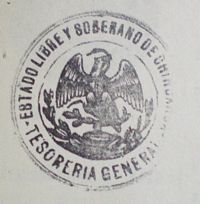 |
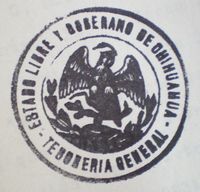 |
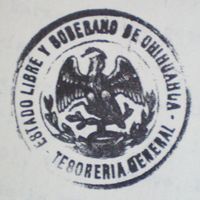 |
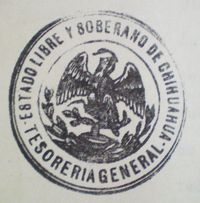 |
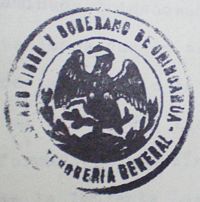 |
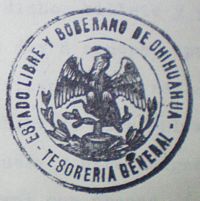 |
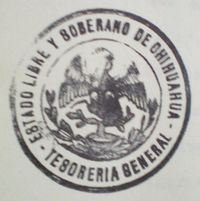 |
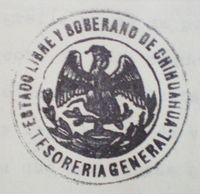 |
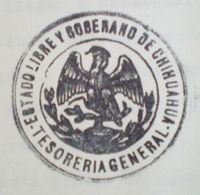 |
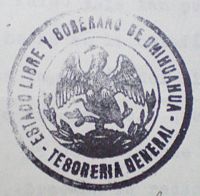 |







